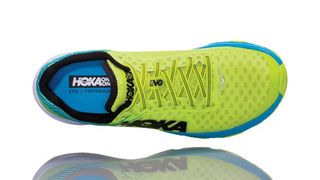You can trust Coach






Given the success Nike has enjoyed with the Zoom Vaporfly 4% it’s no surprise to see other brands launching shoes with carbon-fibre plates. In fact, the only real surprise is how long it’s taken and why more brands haven’t done so – but perhaps the Hoka Carbon Rocket is an indication, because despite having a carbon plate it’s nothing like the Vaporfly.
Nike’s record-setting shoe pairs the plate with the company’s soft and bouncy ZoomX foam, which makes it both forgiving and fast – ideal for long-distance racing. In contrast the Carbon Rocket is probably the stiffest and firmest shoe I’ve ever run in, and that combined with the 1mm drop from heel-to-toe made it a shoe I could only use very sparingly. I’m not well conditioned for that style of shoe – I’m used to 10mm drop shoes and prefer a softer ride.
After an easy 8km in it for my first run, I put it to the test properly with a progression 10K where the last four kilometres were around my 10K race pace. In the midst of a busy marathon training schedule I felt that the stiff and snappy ride of the Carbon Rocket helped me stay on pace in a tough workout where I wouldn’t have been surprised to drop off the pace, but I definitely felt my legs were more beaten up than normal at the end of the run and my calves were tight too. That’s probably down to the shoe’s low drop – I can get by in 4mm shoes, but I’ve never done a lot of running in something so close to a zero-drop shoe, so my body isn’t really used to it.
After taking a few days off from the Carbon Rocket I did my longest run in it – a 90-minute progression run. About 45 minutes in I started to feel pain in my forefoot and although it never became unbearable, that pain stuck with me for the rest of the run. I thought the Carbon Rocket might ease up a little after 80km or so but I’ve seen no sign of that, and every run I’ve done in it over 45 minutes has resulted in forefoot pain. It’s just too stiff for me to use regularly.
Along with the carbon plate the Carbon Rocket has Hoka’s dual-density ProFly midsole, which is softer at the back to cushion your landing and then firmer at the front to provide some pop to your toe-off. I’ve loved this midsole in other Hoka shoes like the Mach and Torrent, but you can’t feel the dual density at all in the Carbon Rocket – it’s just firm all over.
Although it’s certainly a fast shoe, I’d still lean towards softer speed shoes like the Vaporfly, Reebok Floatride Run Fast and Adidas Boston 7 for my fast running, and I also prefer the responsive ride of the Hoka Mach to the Carbon Rocket.
However, it bears repeating that the Carbon Rocket is pretty close to the polar opposite of the shoes I tend to use, and those who do like a low-drop shoe might find it more to their tastes. I’d say it’s still too firm to use more than a couple of times a week, but it’s a speedy option for 5K and 10K races, and maybe half marathons too, though you’ll need some extra time for your legs to recover afterwards.
See related

The bottom of the shoe might divide opinion, but the top is an indisputable success. The upper is lightweight, breathable and holds the foot in place without being overbearing even as you crank up the speed. And the bright yellow colourway is excellent too. I found that the Carbon Rocket was true to size and in line with other Hoka shoes I’ve worn.
If you’re looking at the Carbon Rocket as a cheaper, more durable alternative to the Vaporfly, you’ll be disappointed. It’s a completely different shoe, even if they both contain a carbon-fibre plate. As a lightweight, low-drop racer, the Carbon Rocket and its fast and firm ride will surely delight some runners, but it’s definitely one that won’t work for everyone.

Nick Harris-Fry is a journalist who has been covering health and fitness since 2015. Nick is an avid runner, covering 70-110km a week, which gives him ample opportunity to test a wide range of running shoes and running gear. He is also the chief tester for fitness trackers and running watches, treadmills and exercise bikes, and workout headphones.